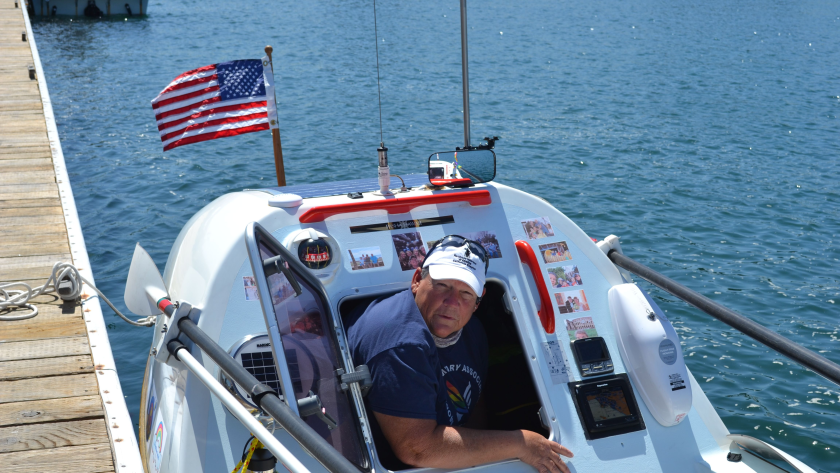At age 60 and paralyzed, she tried to row across the Pacific
Angela Madsen, a military veteran and three-time Paralympian, attempted to be the first paraplegic person to row solo across the Pacific.
The forecast looked ominous, a tropical storm brewing over the Pacific Ocean, threatening strong winds and high seas. That meant trouble for Angela Madsen as she sat in a small boat, hundreds of miles from land.
For weeks she had been rowing across open water, pulling for hours at a time, squeezing into a cramped aft cabin to rest, then starting over again. The fatigue could be numbing, interrupted by pain from sores on salt-crusted skin.
This quest of hers, to row from California to Hawaii alone, brought both frustration and joy, setbacks mitigated by small victories.
“I’ve been able to nudge my way north a bit,” she texted at one point. “Sooo happy about that.”
A solo ocean crossing was audacious for anyone to try; it bordered on madness for a 60-year-old grandmother paralyzed from the waist down.
People had tried to dissuade Madsen, but only a little because they believed she could make it. This was a woman who lost the use of her legs in her mid-30s, winding up homeless for a time and suicidal. She fought back to become an elite athlete, qualifying for three Paralympics in rowing and track and field.
“A pretty fierce competitor,” U.S. coach Erica Wheeler said. “It was just her get-it-done mentality.”
Big and strong, with a broad grin framed by curls of graying hair, Madsen focused on long-distance rowing later in life. She crossed the Atlantic and Indian oceans in pairs and small crews, a warmup for this 2,500-mile attempt to reach Honolulu.
Her 20-foot fiberglass boat, with snarling teeth painted on the bow, had fore and aft cabins and an open space in the middle where she could work the oars. It had all the latest marine technology. But as Madsen reached the halfway point on her route, there was a problem.
A shackle had broken loose on a parachute-like device that deployed below the surface to keep the boat steady in emergencies. The only way to make a fix was from the water. Going over the side would be dicey, but Madsen worried more about the approaching storm.
On Saturday, June 20, she posted on social media: “Tomorrow is a swim day.”
::
The trip began from Marina del Rey in late April and quickly hit rough weather that nearly capsized the boat. Madsen texted: “Stormy and ocean is boiling can’t keep oars in water constantly splashed.”
Even when conditions mellowed, the swell ran as high as eight feet with winds at 10 to 20 knots. “Pretty typical,” said Christopher Landsea of the National Hurricane Center. At some point, Madsen’s electronic gear warned of more bad weather looming to the south; it could not have predicted Tropical Storm Boris would shift direction, staying below her position.
Repairing the parachute anchor must have seemed prudent to someone who liked to keep her vessel, the Row of Life, shipshape. Madsen once told her wife, Deb Madsen, about surviving at sea: “You just have to prepare.”
Resiliency had always been essential for a woman who grew up around lots of brothers in a military family in Ohio. There were occasional tussles and, always, sports. Madsen sprouted to 6 feet 1 by high school, the tallest player on the volleyball team, a hitter who could block at the net.
Any hopes of playing in college evaporated when, at 17, she gave birth to a daughter, Jennifer. After graduating in 1978, Madsen waited a year for her younger brother to finish high school so they could enlist together.
The Marine Corps trained her for military police duty and dispatched her to El Toro, where she could keep Jennifer in family housing. It seemed like just the right place, with a women’s basketball team on base and a beach nearby; Madsen fell in love with surfing.
But life grew complicated when she realized she was gay. The military was years away from “don’t ask, don’t tell” back then and, as she later wrote, “everyone was so fearful and afraid of being outed.”
Things got worse when a hard fall during a basketball game ruptured one disk discs in her back. The injury led to a discharge in 1981 and years of chronic pain as she settled in Southern California, working as a computer-aided drafter. In 1993, she sought treatment at a Veterans Administration hospital in Long Beach.
One surgery led to another, leaving her with a pierced spinal column and partial paralysis that she blamed on doctors. Returning home in a wheelchair, Madsen faced growing tensions with her daughter and an ugly breakup with her girlfriend at the time.
Unable to manage on a slim military pension, she landed on the streets, sleeping beside a bus stop near Disneyland. In a 2014 autobiography, “Rowing Against the Wind,” she wrote that “life has been hard to believe at times and seems like a made-for-TV movie.” Victim mentality took hold, threatening to drag her under.
“It was easy to give up and give in to despair,” she wrote. “The only things I could count were my losses, not my blessings.”
::
In addition to a transponder, solar panels, an emergency beacon and a desalinator for making fresh water, the Row of Life had a satellite telephone. Never much of a phone talker, Madsen tended to communicate by text and social media.
“Horizontal break over,” she wrote after a nap. “Popping Tylenol and getting back at it.”
On Sunday, June 21, Deb began to wonder about the lack of updates on the anchor repair. From home in Long Beach, she could track Madsen’s progress on her smartphone — the boat usually moved two or three knots an hour while being rowed but now drifted with the current.
That evening, she called Soraya Simi, a filmmaker who had spent a year documenting the crossing. Deb told her: “You know, I’m worried. I’m not sure I should be.”
Maybe the day started late and Madsen was still in the water, wrestling with the shackle. Maybe the work had been exhausting and she was asleep. “I knew this was dangerous, but I wasn’t worried she couldn’t fix it,” Deb said. “She had a MacGyver brain — she could fix anything.”
Still, Deb and Simi decided to check with the Coast Guard, which referred their call to a Honolulu base.
Column One
Column One
A showcase for compelling storytelling from the Los Angeles Times.
The Fourteenth District patrols more than 14 million square miles of Pacific Ocean, a territory that stretches seven hours by cutter. Commercial freighters and fishing boats often volunteer to help in a pinch.
“It really is a joint effort out here when something happens,” Petty Officer 3rd Class Matthew West said. “There’s so much ocean to cover.”
As darkness fell on Sunday, it was too late to begin a search; that would have to wait until morning. Deb ran through the possibilities in her head.
“If there were 150 different scenarios, I had thought of them all,” she said. “I had plans for rescue, plans for everything.”
::
Her once-fit body had swelled to 350 pounds. A year after the surgeries, Madsen was still in pain, still in denial about living in a wheelchair.
When doctors offered a bleak prognosis, her despair turned to anger, which might have been the best thing. As she told CNN in 2012, “sometimes when you get pissed, you get motivated.”
Seeking help from a veterans group, Madsen arranged for temporary housing and got another boost from — oddly enough — another setback.
On a visit to San Francisco in 1994, she wheeled through an underground train station and hit a crack in the pavement, tumbling out of her chair, landing head-first on the tracks below. As bystanders pulled her to safety, there was no feeling in any part of her body. Over the next half-hour, as movement returned to her arms and hands, she recalled: “I started being thankful for what I had.”
In her book, she put it another way: “If you don’t paddle your own canoe, you don’t move. You row or die!”
A trip to the 1995 National Veterans Wheelchair Games drew her back to basketball. A few years later, someone invited her to an adaptive rowing clinic where she strapped into a specially equipped scull and, given her affinity for the water, was hooked.
Devilish training led to local races, then larger competitions. A bout with cancer and a double mastectomy barely interrupted her progress as she won gold at the 2000 national championships, followed by a string of world championships.
“Angela was a really special person in the Paralympic world,” said Cathy Sellers, a former U.S. Paralympic executive. “She always went whole hog.”
Life was changing for the better in other ways.
By 2007, Madsen had founded a nonprofit organization to teach rowing to kids with disabilities. Up in Kern County, Deb was working for child protective services and had a difficult case, a boy who used a wheelchair and refused to get out of bed. She wondered if rowing might inspire him, but needed to know more about Madsen’s program.
“I wanted to spy on her, so I went down there and watched how she was with kids,” Deb recalled. “Angela says I was stalking her.”
Not only was rowing a good fit for the boy, it sparked an attraction between the women. Madsen tried to resist, too busy for a relationship, but soon relented. Deb said: “She gave me a ring. She told me, let’s get married and not even date.”
There was still a cantankerous side to her personality, carping at VA staff and fighting with her daughter. But she also helped that same VA staff at volunteer events and counseled younger teammates as the self-appointed “Grandma” on the national team.
In the water, her upper-body strength translated into a seventh-place finish in mixed sculls at the 2008 Beijing Paralympics, which caught the attention of U.S. track coaches. They invited her to an Olympic training center in Chula Vista to try throwing; the other athletes marveled that a 50-ish woman could push herself so hard, day after day, goading them to “suck it up, we’re going to keep working.”
“Angela brought life to the track,” said Liz Willis, an amputee sprinter who roomed with her at camp. “She was larger than life.”
Over the next eight years, Madsen won bronze in the shotput at the 2012 London Paralympics and finished in the top 10 in the shotput and javelin at the 2016 Paralympics in Rio de Janeiro. Age eventually caught up with her, in terms of elite competition, but that did not matter. The sea was calling.
::
Hopes began to fade on Monday, June 22, replaced by a frightful notion. Deb imagined the Row of Life bobbing aimlessly and her wife nearby, motionless in the water.
“I really got a sick feeling in my chest,” she said. “There was something wrong.”
That morning, the Coast Guard checked flight logs and noticed that a military transport plane was crossing the Pacific on a scheduled hop from California to Honolulu. A call went out for help.
The C-17, with its massive fuselage and wingspan, figured to reach Madsen’s location in about four hours but ran into headwinds, making the trip longer as Deb waited for word. Eventually, it found the boat in all that ocean.
Just as Deb had feared, Madsen lay in the water, still attached to the tether she would have used while attempting the repair. As the jet flew low enough for its engines to be heard, crew members radioed Honolulu with a report: Madsen did not respond to their presence.
The Coast Guard had already identified the Polynesia, a German-flagged container ship, to the north, bearing cargo from Oakland to Tahiti. The captain agreed to alter course.
::
Her love of the water was partly physical.
The rigor of scrambling over endless swells, one after another, somehow appealed to her. So did the adrenaline rush of battling squalls and inching across moonless nights when an unseen wave might strike at any moment, sweeping her overboard.
“A combination of two sports,” she wrote. “Rowing and bull riding … like trying to do everything including eating, sleeping and rowing while riding a bull.”
Even the small hardships — freeze-dried food gulped down with a splash of Tabasco, a bucket that served as a bathroom — she wore like a badge of honor. “Went for pain cream last night and grabbed 5200 marine caulk and sealant almost a big oops,” she posted in May.
Long past the thinner days of her youth, Madsen delighted in showing that a big woman could be athletic. But there was another motivation, something harder to describe.
The ocean transported her to a place where, she wrote, “some days would just never end and time would overrun itself.” If the wind and current ran her way, she could let the boat cruise, watching for sea life. On the Hawaii trip, she texted that “two little wahoo swim by the oars and play in the swirls.”
The sky above stretched as deep and wide as the horizon so “you couldn’t help but notice the shades of pink, yellow and blue slowly but intensely transform to orange, purple, crimson and gold,” she wrote. “There were many days when the sun looked like a huge red ball just hovering out there.”
In 2008, Madsen completed her first major voyage with a male amputee partner, the pair rowing 2,552 miles from the Canary Islands to Antigua. Later, she joined small crews that crossed the Indian Ocean and circumnavigated Great Britain. She and another woman made a duo trip from California to Hawaii.
Through all of this, Deb felt mixed emotions. She was always supportive, showing up at track and field practice with a van full of snacks and drinks, and accepting the credit card bills that piled up with each ocean crossing. But she also worried.
“Every single time, Angela told me it would be her last [crossing],” Deb said. “Every time, there was an excuse to do one more.”
Madsen made her first solo attempt at the Pacific in 2013. When gale force winds rose suddenly off the California coast, a freighter tried to rescue her but accidentally sucked the Row of Life up and spit it out the back, with Madsen clinging for life inside one of the watertight compartments. A Coast Guard helicopter eventually lifted her to safety.
After that, Deb said, “I tried really hard to get her to stop.”
::
The Polynesia arrived on site at 6:25 p.m. that Monday, according to Coast Guard records. Crew members pulled Madsen’s body from the sea, cutting the tether, leaving the Row of Life to drift away. Official notification reached Deb as she formulated theories.
It could have been a heart attack that killed her wife. The tether might have tangled, leaving no slack to climb back aboard. Or Madsen might have succumbed to hypothermia.
“She doesn’t have any feeling in her legs,” Deb said. “She wouldn’t realize how cold she was.”
Several days later, the death had yet to hit home; Deb was too busy with logistics. Madsen had once mentioned a burial at sea — “You talk about these things because you know it’s dangerous,” Deb said — but the ship’s crew could not perform this service.
Coronavirus travel restrictions presented another challenge. There was no way to fly to Tahiti to meet the Polynesia and even transporting the body back to the U.S. would be tricky. Madsen’s grandchildren — her daughter died last year — wanted a funeral back home, but Deb did not see the use.
“I love her but I’m not that sentimental about body stuff,” she said. “I don’t think she’s still in her body.”
Something else seemed more important.
For the previous two months, Madsen had been using her satellite phone to transmit photographs, slightly blurry images that nonetheless conveyed a clear picture. “You could see the joy that radiated from her,” Deb said.
To her family and friends, Madsen’s story was too big, too important, to end so abruptly. They want to write a different finish.
Deb has persuaded the Polynesia to keep Angela’s body aboard and drop it off in Los Angeles on the way back. Simi has found a Honolulu boat captain to help look for the Row of Life and a veterans group has started a GoFundMe campaign to cover expenses.
“All these people helping out,” Deb said. “I want to text Angela and say you’ll never believe this.”
The plan is to get Madsen — and her boat — to Hawaii. No one can change what happened out there on the Pacific Ocean, no one can bring her back, but they can help her finish the crossing.
More to Read
Go beyond the scoreboard
Get the latest on L.A.'s teams in the daily Sports Report newsletter.
You may occasionally receive promotional content from the Los Angeles Times.










